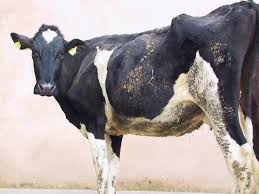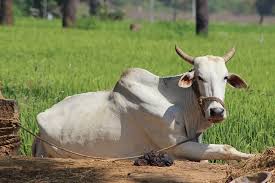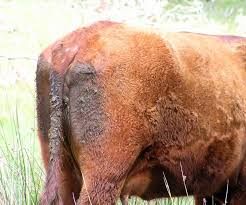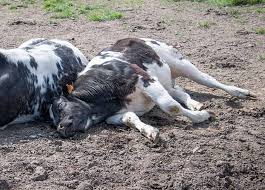Disease can be defined as any abnormal structural or functional change in the tissues of an animal. The direct or indirect causes of disease are numerous.
In cattle, these causes can be categorized into trauma, chemical causes, faulty nutrition, poisons of various kinds, internal and external parasites, bacteria, viruses, protozoans, and congenital conditions.
A parasite is defined as a plant or animal that lives upon or within another living organism, deriving benefit at the expense of the host.
Read Also: Best Snail Rearing Stocking Density for Best Results
Causes of Disease in Cattle

Cattle diseases can be attributed to several causes, which include mechanical injuries, chemicals, faulty nutrition, and infections from various organisms.
1. Mechanical Causes of Disease
Mechanical causes are involved not only in external injuries but also in conditions such as stomatitis due to sharp objects (e.g., a long sharp slime on a seed), mechanical pneumonia, traumatic gastritis (inflammation of the stomach lining), and injuries incurred during calving (parturition) by inexperienced handlers.
2. Chemical Causes of Disease In Cattle
Chemical causes may lead to injury through caustic actions, but the main abnormal conditions arise from the absorption of chemical poisons following accidental access or from toxic drugs administered incorrectly. Examples include sodium nitrate, arsenic, and various other chemical poisons. Plant poisoning is another common chemical cause of disease.
Faulty Nutrition and Its Role in Cattle Diseases

Faulty nutrition is a significant factor in the development of many cattle diseases. Understanding proper cattle nutrition, including the prevention of nutritional deficiencies, is essential for effective cattle husbandry. Cattle farmers should stay updated on the latest knowledge regarding animal nutrition to avoid these issues.
Bacteria, Viruses, and Protozoans in Cattle Diseases
These infectious agents invade the body through various routes, such as the digestive, respiratory, and genitourinary tracts, or through the skin. The ability of these agents to cause disease depends on the virulence of the organisms, the level of exposure (i.e., the number of organisms), and the resistance of the host animal.
Disease-causing agents are transmitted between animals by biting insects, direct contact between susceptible and infected animals, or indirectly through contaminated surroundings.
A. Bacterial Diseases in Cattle
1. Anthrax: is a bacterial disease that can be transmitted through contaminated water, food, or wound infections. It has an incubation period ranging from a few hours to one or two weeks and can lead to sudden death in cattle. Vaccination is an effective preventive measure.
2. Contagious Bovine Pleuropneumonia (CBPP): is another bacterial infection spread through close contact with infected animals or inhalation of the disease organisms. The disease’s incubation period ranges from 14 days to several months.
YvSymptoms include painful coughing, often accompanied by gasping and thick mucus discharge. The animal may die within one to three days. Vaccination, along with the culling of severely affected animals, can help control the spread of CBPP.
Vv
B. Viral Diseases in Cattle
1. Foot and Mouth Disease (FMD): is a viral disease transmitted through direct contact with infected animals or contaminated materials. Symptoms include excessive salivation, blisters on the tongue and feet, high fever, and lameness. Prevention involves isolation, strict sanitation, and vaccination of valuable livestock.
2. Rinderpest: (cattle plague) is another viral disease spread by direct contact or exposure to contaminated materials. Symptoms include high fever, blood-stained diarrhea, and severe mouth lesions. Vaccination of calves and a booster at 12 months can prevent this deadly disease.
C. Protozoan Diseases in Cattle
Protozoan diseases are caused by single-celled organisms and include:
1. Trypanosomiasis (Magana): which is transmitted by tsetse flies, leading to intermittent fever, restlessness, emaciation, and death. Fly eradication, using trypanotolerant breeds, or chemoprophylaxis can help control this disease.
2. Piroplasmosis (Babesiosis or Red Water): is transmitted by infective ticks and causes fever, reddish urine, and progressive weakness. Tick control and immunisation are key preventive measures.
Read Also: Seasonal and Daily Management Practices for Snail
Internal Parasites in Cattle

Internal parasites, including protozoa and helminths (worms), can cause significant health issues in cattle. Regular deworming and maintaining proper herd management practices are crucial for controlling these parasites.
External Parasites of Cattle
External parasites, mainly ticks and biting flies, can cause several diseases in cattle, often referred to as rickettsial diseases. One such disease is
1. Heartwater, caused by ticks and characterised by high fever, neurological signs, and sudden death.
2. Anaplasmosis, caused by infective ticks or contaminated equipment, results in high fever, jaundice, laboured breathing, and unsteady gait. The disease can range from acute to mild and chronic, with more severe outcomes in older cattle. Preventive measures include early-stage chemotherapy and vaccination for control.
In conclusion, understanding the causes and prevention methods of cattle diseases is essential for maintaining the health and productivity of livestock. Regular management practices, vaccination, and proper nutrition can help prevent many common diseases caused by parasites, bacteria, viruses, and other factors.
Do you have any questions, suggestions, or contributions? If so, please feel free to use the comment box below to share your thoughts. We also encourage you to kindly share this information with others who might benefit from it. Since we can’t reach everyone at once, we truly appreciate your help in spreading the word. Thank you so much for your support and for sharing!

